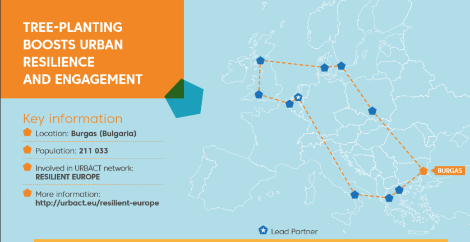Burgas (BG) - Tree-planting boosts urban resilience and engagement
2019
To help mitigate the impacts of serious floods, the city of Burgas piloted new, successful forms of citizen engagement — and, armed with a supply of trees, built support for improving urban resilience in a collaborative way.
To download : urbact-citystories-burgas.pdf (1.1 MiB)

Burgas, Bulgaria’s fourth-largest city, is situated on the Black Sea coast and is home to a large complex of salt lakes. All this water makes the city particularly vulnerable to flooding. In recent years, Burgas has been hit by severe floods, while also struggling with ageing infrastructure and a lack of preparedness for times of crisis. Before joining the URBACT RESILIENT EUROPE network, public participation and trust in local government were low and resources for testing solutions were limited.
An introduction to resilience
By joining RESILIENT EUROPE, Burgas wanted to become a more resilient city in light of its vulnerability to flooding. Once in the network, the city set up a group of local stakeholders, an URBACT Local Group, to produce an Integrated Action Plan around resilience. This word was a new concept for many of the local stakeholders gathered at the first group’s meeting, but was immediately embraced as a valuable cross-sector framework for tackling environmental problems and enhancing the city’s strength. It also provided an opportunity to think in new ways, looking towards citizen-engaged, ‘softer’ approaches rather than simply relying on large-scale infrastructural changes.
Neighbourhood testing ground
Burgas’ URBACT Local Group included policy officers from various city departments, along with NGOs and local businesses. Having discussed the city’s major climatic stresses and how best to engage residents in positive change, the group proposed the area of Dolno Ezerovo as a test site for strengthening urban resilience in a collaborative way. Just west of Burgas city centre, near the Vaya Lake, Dolno Ezerovo has experienced destructive flooding in recent years due to high levels of rainfall and runoff. Most of the neighbourhood is below sea level, and its drainage infrastructure is ageing. The URBACT Local Group designed a pilot programme that would launch local efforts to increase flooding resilience through nature-based and citizen-engaged solutions. This involved planting flood-mitigating trees, as well as strengthening collaboration between the municipality and community to help tackle urban resilience issues better in future. Burgas had struggled with citizen engagement previously, and some residents mistrusted the municipality. So the URBACT Local Group appointed the head of the local centre for administrative services to act as mediator between the municipality and Dolno Ezerovo residents. Members of the city government also went door-to-door around the area, talking to citizens about the pilot project and development of an integrated plan for future actions. School teachers taught local children about the importance of urban resilience. Residents were then invited to a meeting to decide where to plant the trees — thus giving the community a say in improving their neighbourhood’s resilience to flooding.
Planting a future
The URBACT Local Group organised a community event to plant five willow trees in Dolno Ezerovo’s central square — a pleasant public space before flooding caused it to become waterlogged. At the popular event, where residents helped plant trees, the municipality also received community input on their Integrated Action Plan. Residents were enthusiastic about the chance to share their opinions and ideas; those who remembered the area’s deforestation 20 years earlier blamed increased local flooding on the lack of trees, and agreed that reforestation would help mitigate flood impact. Collaborating with citizens of all ages, 35 more trees were planted at places in the neighbourhood identified as most vulnerable to flooding. The trees were selected to survive in wet environments and withstand future floods. Although relatively small-scale, the tree-planting helped demonstrate what could be achieved with low-cost green measures — and strengthened public support for the plan. The URBACT Local Group continued to work alongside residents to develop the integrated plan, which proposes a range of tools to mitigate flooding in the neighbourhood, including: training courses on flood preparedness and resilience for citizens; tutor sessions on environmental resilience for school children; construction of detention basins to store rainwater; better maintenance of drainage infrastructure; establishment of warning systems; replacement of non-perennial with perennial plants; maintaining active communication between citizens and municipality, online and face-to-face. It’s hoped these tools will inspire similar actions across the whole city.
URBACT impact: a more engaged community
Through the RESILIENT EUROPE network, the city of Burgas learned new ways to involve citizens in shaping plans, understood the value of engaging the community in urban resilience and massively increased stakeholder participation in municipal activity. Citizens, meanwhile, regained trust in the municipality through their involvement in creating the integrated plan — and built awareness of measures that can be taken to improve flooding resilience. “Burgas did excellent work by involving the citizens that before were very sceptical and even suspicious of the city officers,” explains the Lead Expert of the network, Niki Frantzeskaki. Georgi Sakaliev of Burgas’ Territorial Cooperation Department adds: “The URBACT programme was a great opportunity for the city of Burgas to become a partner in a network that enriched the horizons of the city experts when it comes to urban adaptation and strengthened the city’s capacity in dealing with climate change. » The city now hopes to build on their RESILIENT EUROPE experience and secure resources to implement the integrated action plan.